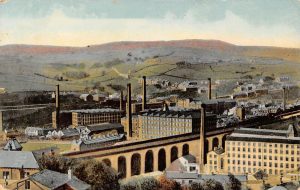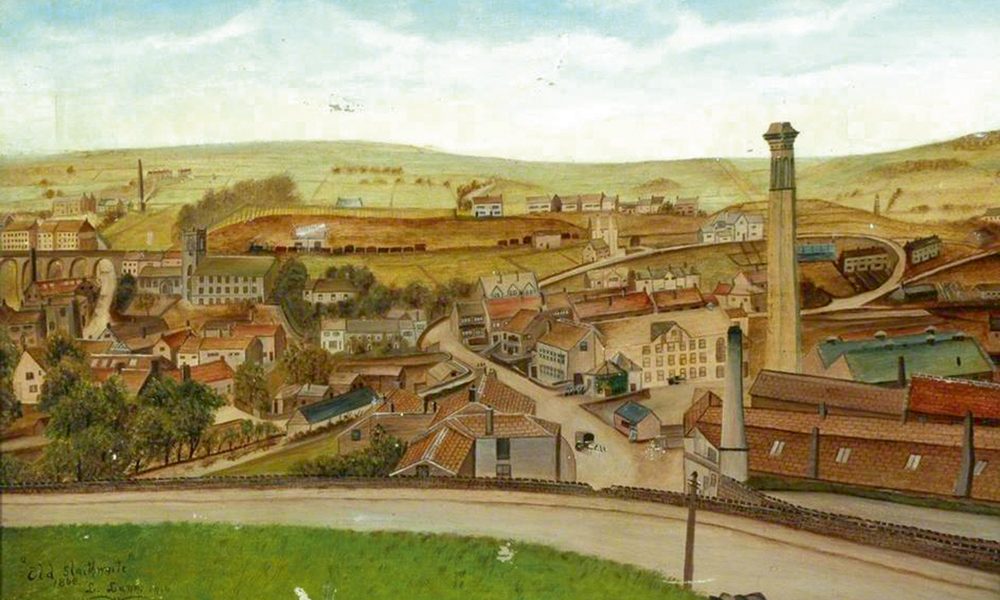Slaithwaite Reflections of yesterday.
Table of Contents
Slaithwaite
Reflections of yesterday.
By Mark Sheppard
“Twit-Twoo”
it’s “Slawit” to you!

Slaithwaite, known locally as Slawit, is a a village within the Colne Valley region, lying across the River Colne and the Huddersfield Narrow Canal.
The village was part of the Earl of Dartmouth estates, a chapelry, in the parishes of Huddersfield and Almondbury union of
Huddersfield, Upper division of the wapentake of Agbrigg and included the township of ‘Lingarths’ (Lingards).
In the early 19th century a local spring was discovered to contain sulphurous properties and minerals, similar to those found in Harrogate. Sometime after 1820, a bathing facility was built, along with gardens and pleasure ground, with some visitor cottages.A free school was founded in 1721 and
rebuilt twice: first in 1744, and again in 1842.
In the 1848 edition of ‘A Topographical Dictionary of England’, Samuel Lewis (the editor) wrote:- “the lands are in meadow and pasture,with a small portion of arable; the scenery is bold and romantic. In the quarries of the district are found vegetable fossils, especially firs and other mountain trees.The village is beautifully seated in the valley of the River Colne; the inhabitants are chiefly employed in the woollen manufacture, in the spinning of cotton and silk, and in
silk-weaving”
Slaithwaite Hall, thought to date from the mid-15th century, is located on a nearby hillside. It is one of a number of cruck-framed buildings clustered in this area of WestYorkshire.After many years divided into cottages, the building has been extensively restored and is now a single dwelling.
Legend has it that local smugglers caught by the excise men tried to explain their nocturnal activities as ‘raking the moon from the canal’ and definitely not as ‘fishing out smuggled brandy.

A “Moonraker” is now the official nickname for a native of the village. Similar stories and nicknames exist for the neighbouring villages of Golcar (“Lillies”), Marsden (“Cuckoos”) and Linthwaite (“Leadboilers”).
An apocryphal story associated with Slaithwaite is that in the 19th century, when tenants came to the village to pay their annual rent, The 5th Earl of Dartmouth would provide ‘rent dinners’ and that the shoulder of mutton was the most favoured with the tables of hot roast beef, mutton and tongue (cooked together in the set pot) being available there at that time.
On the 3rd and 4th September 1762, John France of Slaithwaite had a foot-race against time, for a considerable wager. He was allowed 28 hours to run 100 miles and won by only six minutes.
In 1771 a notice appeared in the Leeds Intelligencer newspaper saying that the Manor of Slaithwaite and Lingards belonging to the Earl of Dartmouth, and that the game in the district had been much destroyed.
In the spring of 1795, a man from a Slaithwaite pub was later kicked to death by a soldier, for refusing to join the Wakefield regiment, the soldier was subsequently hanged.
In 1810, Joseph Sykes kept the Old Bank, George Dodson the Shoulder of Mutton, Samuel Wood the Quiet Woman, John Bottomley the Pole, later The Sun, and Joseph Holroyd the Dyers Arms at Lingards. In 1834 the Dartmouth Arms was kept by John Bamforth, the Globe by Humphrey Wood, the Harp by John Schofield, and the Star by Joseph Parkin.
The half-yearly rent audit of the
Earl of Dartmouth was held at the Dartmouth Arms Inn, still kept by John Bamforth in early June 1856. The Earl was lord of the manor of Slaithwaite and visited the town in November 1860. In February 1865, a drunken man going home from a beer shop at Slaithwaite fell down and was frozen to death.
The four large mills of the Slaithwaite Spinning Company formed in 1877, which when fully staffed employed 1000 workpeople, were sold by auction on Tuesday 17th May 1938 for £12,760
At half past five on Thursday afternoon 6th December 1883, a fire broke out at Waterside Mill, Slaithwaite which belonged to the Earl of Dartmouth and occupied by John & Thomas Garside, woollen manufactures and cloth spinners, which resulted in the old mill being burnt down within an hour. In September 1901, the Sun Inn closed.
By Mark Sheppard











